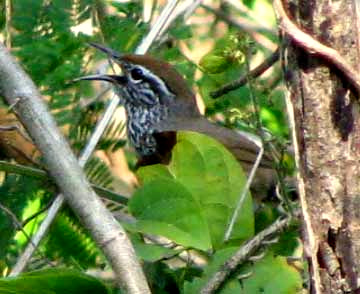Excerpts from Jim Conrad's
Naturalist Newsletter
from the April 3, 2011 Newsletter issued from Hacienda Chichen Resort beside Chichén Itzá Ruins, central Yucatán, MÉXICO; limestone bedrock, elevation ~39m (~128ft), ~N20.676°, ~W88.569°
LITTLE WREN WITH A BIG VOICE

Above, that's a Spot-breasted Wren. Though the species is fairly common from northeastern Mexico to Costa Rica, they're hard to see and even harder to photograph. To get this picture I'd had to blindly point and snap where I thought he was, but didn't even know I'd gotten him until the image was on my screen. Spot-breasted Wrens skulk in deep shade in heavy, often vine-covered thickets hardly ever affording a good view.
But from within their murky shelters these birds call very loudly and piercingly, SWEE hu-a WEE-a-hew, SWEE hu-a WEE-a-hew... again and again.
Seeing the small size, rufous back and white eyestripe, birders in eastern North America will be reminded of the Carolina Wren, with a similarly loud call. In fact, the two birds belong to the same genus, The Spot-breasted being THRYOTHORUS MACULIPECTUS while the Carolina is Thryothorus ludovicianus.
In the Yucatan no other small wren beside the Spot-breasted has such a heavily spotted breast. The Yucatan Wren on the northern coast has a spotted breast but it's a big wren, 7 inches long (18cm) compared to the 5.3-inch long (13cm) Spotted-breast.